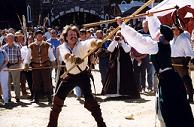|
A quarterstaff is a
medieval English weapon, consisting of a shaft of hardwood, sometimes with
metal-reinforced tips. The name is also used for the fighting staves of
other cultures, such as the
Japanese bō,
Chinese gùn, or French bâton,
Portuguese pau and Italian bastone. |
 |
|
The quarterstaff may be made
from many kinds of wood, commonly ash, oak, hazel, or hawthorn. It may have
metal spikes or caps at one or both ends; these are depicted or referred to
in some Elizabethan and Jacobean sources. The length of the staff varies,
typically ranging from 1.8 m to 2.7 m (6 to 9 feet); in addition, long
staves of 3.6 to as much as 5.4 metres (12 to as much as 18 feet) were
employed in Early Modern times. The weapon seems to have become shorter and
lighter later in its history, though 3-meter staves (made of bamboo or ash)
wood were still sometimes employed in Victorian England.
The quarterstaff is effectively a long two-handed club, although its weight
distribution is generally even throughout its entire length (some forms did
have weighted tips, however). It was used both to deliver crushing blows,
and to thrust like a spear. The art of using the staff was closely related
to that of other polearms, and it was often employed as a training weapon
for the latter. Moves include many different forms of blocks, thrusts,
strikes, and sweeps.
The staff, being a very simple
weapon to manufacture, has a long history of use, and a wide cultural
dispersion. The staff is a traditional weapon of many Asian martial arts.
The quarterstaff proper was historically a common weapon in England, where
it is featured in the Robin Hood legend as the favorite weapon of Little
John. There are also many tools that can easily be used as or quickly
converted to a staff.
The oldest surviving treatise describing staff combat dates from the 15th
Century though George Silver describes its use as being similar to that of
the two handed sword. During the 1500s quarterstaves were favoured as
weapons by the London Masters of Defence and by the 1700s the weapon became
popularly associated with gladiatorial prize playing. A modified version of
quarterstaff fencing, employing bamboo or ash staves and protective
equipment adapted from fencing, boxing and cricket was revived as a sport in
some London fencing schools and at the Aldershot Military Training School
during the later 1800s. |













